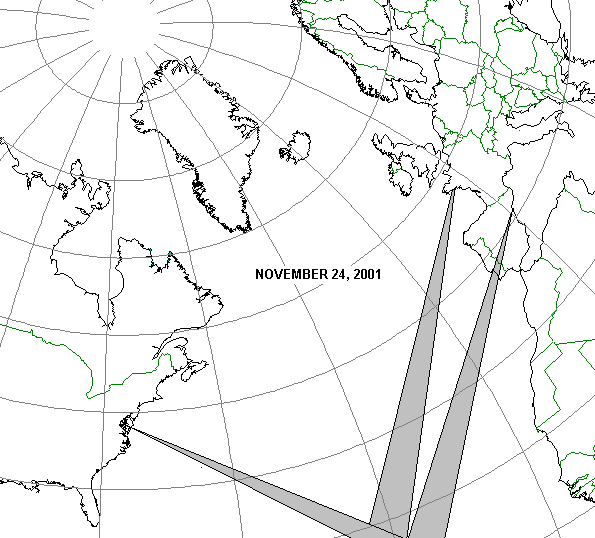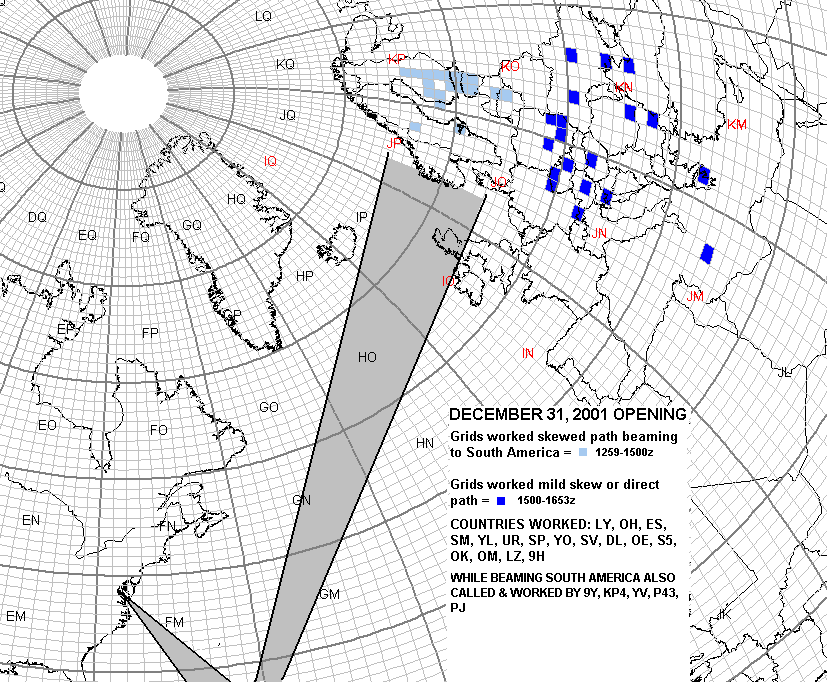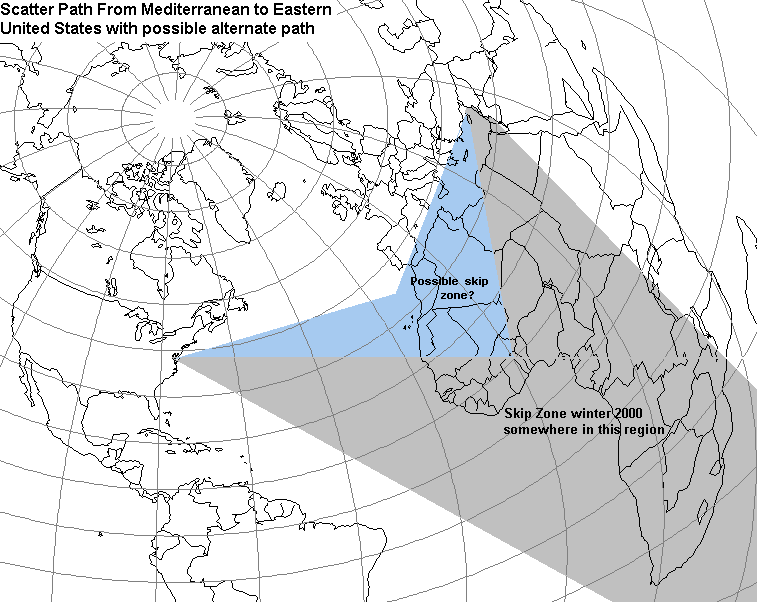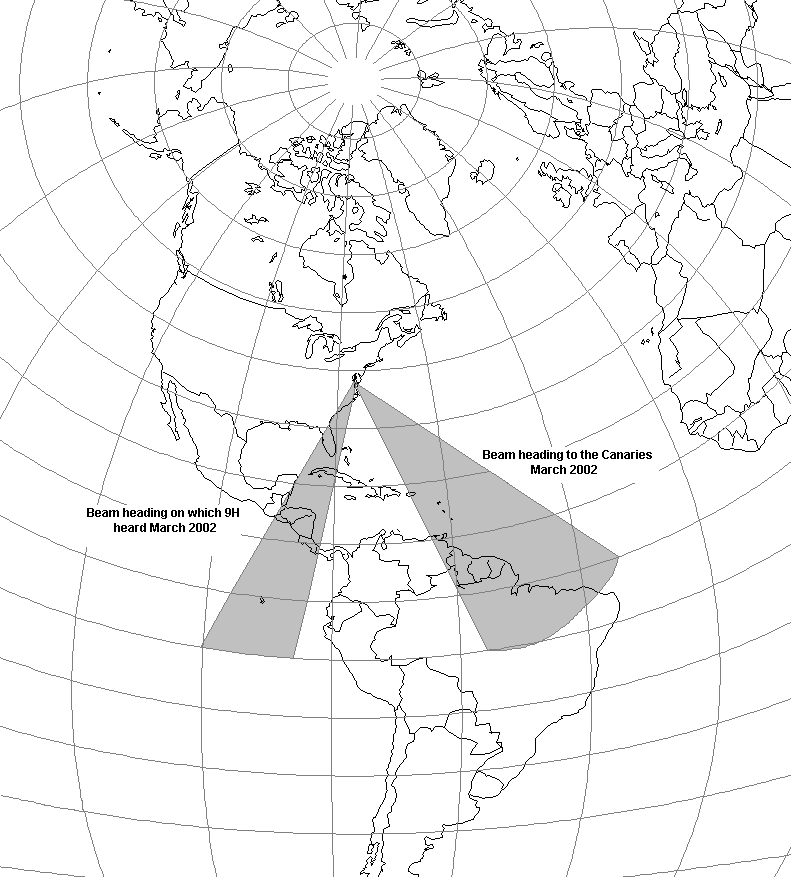East Coast to Europe & Mediterranean Beaming South America |
| During the fall and winter of solar peak years it is sometimes possible to work into Europe from the East Coast of the United States on a beam heading somewhere between the direct heading to Brasil and South Africa. The path seems to exist only via F2, and beam heading varies somewhat with each event. The first event along this path I participated in occurred on November 24, 2001, when I worked F5JKK and EH3AVQ while beaming about 115 degrees. |
 |
| Signals were weak, and I was unable to complete with a number of other stations I heard. Earlier in the day an impacting CME created an aurora, and I heard a number of New England stations via that mode before signals died out completely. I worked AA6TT in FN34 at 1411z rst 52a & 55a. F5JKK was logged at 1651z and EH3AVQ at 1722z. Signals from both Europeans were non-auroral, and as one might expect, sounded simply like F2 signals, albeit attenuated. In my view this opening was precipitated by the geomagnetic disturbance caused by the CME. Note that the point of intersection between the beam headings occurs at approximately the position of the equatorial "fountain" which lies 15 to 20 degrees north of the geomagnetic equator, which itself dips slightly southward between North Africa and South America. My guess is that enhaced ionization from the CME charged the equatorial bulge sufficiently to reflect 50MHz signals at that point. The MUF at lower F2 heights north of the bulge may have been incapable of reflecting 50 MHz signals, but could have bend them downward at an angle sufficient to allow them to reflect off the towering wall of ionization at the bulge. |
| Openings on December 30, 2001 and December 31, 2001 were skewed even further to the south, with a beam heading of 125 & 140 degrees respectively. On December 31, it was extremely strong, and it lasted for over two hours. Near the end of the December 31 skew path opening, a direct path to Southeastern Europe and the Mediteranean opened as well. As the map below shows, there was a defined boundary between the areas worked. Grids worked via a direct path were all south of a line running East to West roughly halfway through the KO & JO fields. The beam heading of the European stations worked skew that morning may have been varied, and the reflection point may have been somewhat further South than the map indicates. |
 |
| It is also possible to work Middle Eastern stations from the United States along a similar skewed path. In the fall of 2000 I was cqing towards central and southern Africa and was called by a station in Israel which was listening for stations in Africa. My low power output at the time, and a failure on my part to understand the path resulted in an incomplete QSO. Indeed, as I turned my beam on the direct heading I lost the signal completely. I rather imagine the 4X station did the same thing! Though I have not seen any such skew path QSOs logged in my 2 years on the band, I believe this path will also recur. Solar numbers during October 2000 were not particularly high -indeed very little direct path activity was heard here the entire fall and winter of that year- and thus it could pay to try this path even when peak year solar conditions are sub-par. |
 |
| During the spring of 2002 I was also able to work the Canary Islands beaming towards South America. The signals were noticeably weaker than that I experienced during the winter skew openings, but with sufficient ionization the path proved possible during the spring. Incredibly, I also heard, but did not work, a 9H station beaming at 205 degrees on March 20, 2002, 2348z. The path is seemingly impossible- I can only guess that this was some sort of backscatter out from the equatorial bulge. |
 |
| There sometimes seem to be a few clues as to when these paths could be productive. For the skew path to the Middle East, there was noticeable backscatter along the path, and though I cannot recall for certain, the 7Q7SIX beacon may have been audible here as well. Along the skew path to Europe, clues were varied. On November 24 there seemed to be no sign at all here other than CQs from Euorpean stations along the path. On December 30 & especially Dec 31, 48 MHz video was loud along this path while inaudible direct. In sum, 48 & 49 MHz video on these beam headings is probably the best indicator of a possible path, but it also pays to listen & CQ on it occassionally as well. As with most openings, high power helps considerably, and don't forget- these are almost certainly strictly F2 or Es plus F2 link paths that are unlikely to work during the waining years of the solar cycle. |
© David H. Craig 2002 |